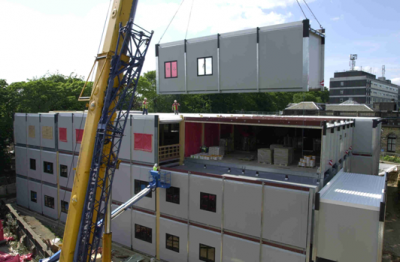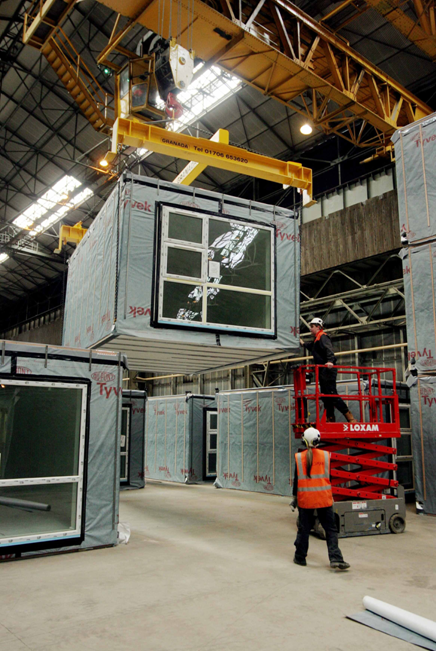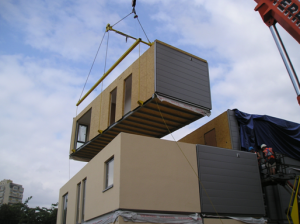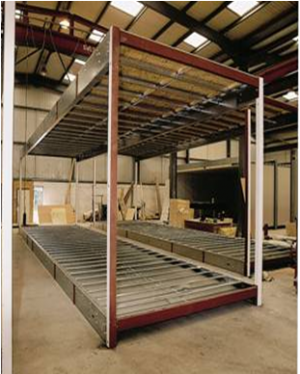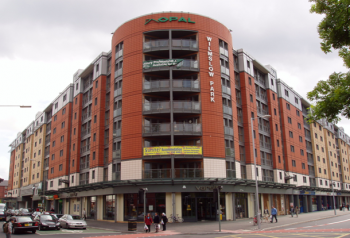Modular Construction
What is Modular Construction
Modular construction refers to a modern construction method. In this method, buildings are divided into sections called "modules". These modules will be constructed off site as individual minor projects and will be delivered to the construction site and assembled as large volumetric components or as substantial elements of a building [1].
| On-site modular construction [1] |
|---|
Advantages of Modular Construction
As a highly innovative and efficient method of construction, modular construction has many advantages when comparing the traditional construction methods. These advantages include [1]:
- Rapid installation on site
- High level of quality control
- Low weight leading to cheaper foundations
- Adaptable for future extensions
- Suitable for projects with site constraints
- Economy of scale through repetitive manufacture
- Limited disruption in the vicinity of the construction site
Disadvantages of Modular Construction
Despite its efficiency and quality, modular construction does have some disadvantages including [2]:
- Complicated government approval process
- Complicated designing process
- Transportation risk and fees
- Land and location restrictions
- Fewer supplier when comparing to transitional industry
- Limited customization
Modular Construction and the Environment
When comparing to traditional constructions methods, modular construction is considered to be more sustainable and have serval ecological benefits. First of all, modular constructions have extreme high reusability as it can be disassembled and relocated rather than demolished. In addition, in a factory environment, material waste can be more strictly monitored as to an on site construction. Moreover, rapid on site assembly leads to less air pollution [3]. It is estimated that by using modular and off-site construction, construction waste can be reduced by 90% [4].
Types of Modular Construction
Permanent Modular Constructions (PMC)
PMCs are permanent building such as real state that are meant to occupy the lot for a considerable long duration. PMC modules can be integrated into site built project or stand along as a turn-key solution [3].
| Building of permanent modular construction [3] |
|---|
Relocatable Building (RB)
RBs are partially or completely assembled that can be relocated. These buildings can be utilized for various purpose such as temporary classroom, construction site office, medical clinics or sales centers etc. [3]. They can be easily disassembled when they have fulfilled their purpose and can be easily reassembled at another location.
| A relocatable building [3] |
|---|
Main Module Types
In modular construction, modules are individual parts that makes up the whole building [1]. There are many types of module each with their own purpose, however, the following are some of the most common modules used in the industry.
4-sided modules
4-sided modules are manufactured with four closed sides. These modules create cellular spaces that are capable of supporting the vertical load from modules above. They are manufactured from a series of 2D panels starting with the floor cassette, then assembled together.
| A 4-sided module [1] |
|---|
Partially open-sided modules
Partially open-sided modules have openings on their side, supported by a stiff continuous edge beam in the floor cassette. The size of the opening is dependent on the properties of the edge member. These modules can be used for applications such as doors or windows.
| A partially open-sided module [1] |
|---|
Open-sided modules
These modules have fully opened sides. Their loads are transferred to the corner posts through means of longitudinal edge beams. Open-sided modules are only stable when used for a few stories, therefore, they are not often used in construction more than three stories.
| An open-sided module [1] |
|---|
Modules supported by a primary structure
Some modules are designed as an add-on to an existing primary structure. Primary structures are designed as steel framework with beams and columns which align the modules. These types of modules are often used for mixed retail, commercial, and residential developments in urban areas.
| An example of module supported by a primary structure [1] |
|---|
|
Contributors:
User Last Update Former user (Deleted) 1410 days ago Former user (Deleted) 1411 days ago Former user (Deleted) 1415 days ago
